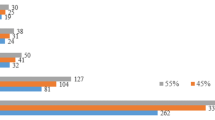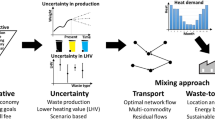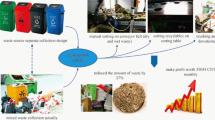Abstract
This study attempts the development of an algorithm in order to present a step by step selection method for the location and the size of a waste-to-energy facility targeting the maximum output energy, also considering the basic obstacle which is in many cases, the gate fee. Various parameters identified and evaluated in order to formulate the proposed decision making method in the form of an algorithm. The principle simulation input is the amount of municipal solid wastes (MSW) available for incineration and along with its net calorific value are the most important factors for the feasibility of the plant. Moreover, the research is focused both on the parameters that could increase the energy production and those that affect the R1 energy efficiency factor. Estimation of the final gate fee is achieved through the economic analysis of the entire project by investigating both expenses and revenues which are expected according to the selected site and outputs of the facility. In this point, a number of commonly revenue methods were included in the algorithm. The developed algorithm has been validated using three case studies in Greece—Athens, Thessaloniki, and Central Greece, where the cities of Larisa and Volos have been selected for the application of the proposed decision making tool. These case studies were selected based on a previous publication made by two of the authors, in which these areas where examined. Results reveal that the development of a «solid» methodological approach in selecting the site and the size of waste-to-energy (WtE) facility can be feasible. However, the maximization of the energy efficiency factor R1 requires high utilization factors while the minimization of the final gate fee requires high R1 and high metals recovery from the bottom ash as well as economic exploitation of recovered raw materials if any.



Similar content being viewed by others
References
Castagna A, Casagrand M, Zeni A, Girelli E, Rada EC, Ragazzi M, Apostol T (2013) 3R’S from citizen’s point of view and their proposal from a case-study. Mech Eng 75(4):253–264
CEWEP Confederation of European Waste to Energy Plants (2012) Energy report III 2007–2010
Chaliki P, Psomopoulos CS, Themelis NJ (2016) WTE plants installed in European cities. A review of success stories. Manag Environ Qual 27(5):606–620
Chefdebien H, Perron-Pique G (2014) R1 climate correction factor for waste to energy plants finally agreed. https://waste-management-world.com/a/r1-climate-correction-factor-for-waste-to-energy-plants-finally-agreed
Christensen T (2011) Solid waste technology and management. Blackwell publishing Ltd., UK
Connolly D, Mathiesen BV, Stergaard PA, Moller B, Nielsen S, Lund H, Persson U, Werner S, Grozinger J, Boermans T, Bosquet M, Trier D (2013) Heat Roadmap Europe 2050. Aalborg University. www.euroheat.org [Accesed 19 November 2015]
ELSTAT (2012) Hellenic Statistical Authority. Census of 2011
EUROSTAT (2014) European Statistics. Waste generated. Municipal waste generation and treatment, by type of treatment method, [online]. Available from http://epp.eurostat.ec.europa.eu [Accesed 3 November 2014]
Ferdan T, Somplak R, Zaviralova L, Pavlas M, Fryba L (2015) A waste-to-energy project: a complex approach towards the assessment of investment risks. Appl Therm Eng 89:1127–1136
Gallardo A, Carlos M, Peris M, Colomer MFJ (2014) Methodology to design a municipal solid waste generation and composition map: a case study. Waste Manag 34:1920–1931
Hogg D (2011) Costs for Municipal Waste Management in the EU: Final Report to Directorate General Environment, European Commission
Karagiannidis A, Barton JR, Karkanias C, Kalogirou E, Papageorgiou A (2010) Estimation of the climate change impact of municipal solid waste management: the case study of Athens greater area. Proceedings Venice 2010, Third International Symposium on Energy from Biomass and Waste, Venice, Italy; 8–11 November
Kyriakis E., (2016). Site and size selection methodology of WtE facilities targeting R1 maximization and gate fee minimization. Case studies: Athens, Thessaloniki and Central Greece. MSc Thesis. Heriot-Watt University.
Kyriakis E, Psomopoulos C, Kokkotis P, Bourtsalas A, Themelis N, (2016) Site and size selection methodology of Waste-to-Energy facilities targeting R1 maximization and gate fee minimization. A concrete approach. 13th International Conference on Protection and Restoration of the Environment”, 3rd to 8th July, 2016, Mykonos island, Greece
Murphy JD, McKeogh E (2004) Technical, economic and environmental analysis of energy production from municipal solid waste. Renew Energy 29:1043–1057
Perkoulidis G, Kasampalis T, Moussiopoulos N (2015) Development of Waste-to-Energy plants, database for evaluation the efficiency of energy recovery from waste in Europe. Waste and Biomass Valoriz 6(3)
Pardo N, Vatopoulos K, Krook-Riekkola A, Moya JA, Perez A (2012) Heat and cooling demand and market perspective, European Commission, Joint Research Centre, Institute for Energy and Transport. doi:10.2790/56592
Pires A, Martinho G, Chang N-B (2011) Solid waste management in European countries: a review of systems analysis techniques. J Environ Manag 92:1033–1050
Psomopoulos CS, Themelis NJ (2014) A guidebook for sustainable waste management in Latin America. 4th IRRC Conference in Waste to Energy, September 2014, Vienna
Psomopoulos CS, Stavroulakis S, Stavropoulos V, Themelis N (2013) Greenhouse gases emission reduction potential in Greece by implementing WTE facilities in strategically selected urban areas. Fresenius Environ Bull 22(7a):2042–2047
Stehlik P (2009) Contribution to advances in waste-to-energy technologies. J Clean Prod 17:919–931
Themelis NJ, Barrigga MED, Estevez P, Velasco MG (2013) Guidebook for the application of waste to energy technologies in Latin America and the Caribbean. Columbia University, Earth Engineering Centre, New York
Acknowledgements
An initial version of the paper has been presented in the “13th International Conference on Protection and Restoration of the Environment”, 3rd to 8th July, 2016, Mykonos Island, Greece.
Author information
Authors and Affiliations
Corresponding author
Additional information
Responsible editor: Philippe Garrigues
Rights and permissions
About this article
Cite this article
Kyriakis, E., Psomopoulos, C., Kokkotis, P. et al. A step by step selection method for the location and the size of a waste-to-energy facility targeting the maximum output energy and minimization of gate fee. Environ Sci Pollut Res 25, 26715–26724 (2018). https://doi.org/10.1007/s11356-017-9488-1
Received:
Accepted:
Published:
Issue Date:
DOI: https://doi.org/10.1007/s11356-017-9488-1




